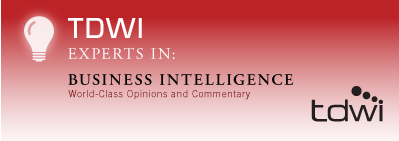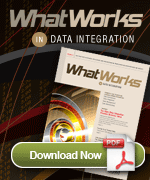

| EDUCATION |
|
TDWI Business Intelligence Fundamentals:
From Data Warehousing to Business Impact TDWI Project Management for Business
Intelligence Delivering BI for Mobile Users |
| WHITE PAPERS | |
|
| WEBINARS | ||||||||||||||||||
|
||||||||||||||||||
| ABOUT TDWI EXPERTS |
TDWI Experts is a twice-monthly e-newsletter where BI/DW thought leaders share opinions and commentary about relevant industry topics and the latest technologies. |


July 7, 2011
IT's Role in Self-Service BI and Analytics
David Stodder
Director of TDWI Research
for Business Intelligence
Topic: Experts in BI
"Self-service" is one of the hottest trends in business intelligence and analytics. BI tool providers as well as vendors in the relatively new data discovery category are competing hard to show that their products have plenty of self-service capabilities. However, self- service BI should not be translated to mean "Users, you're on your own!" It's never fun to have to play the adult at a freewheeling teenager's party, but IT has vital data provisioning and governance roles to play in self-service BI scenarios. As users pursue self-service, IT needs to provide full service.
The way the story is told, users are yearning to breathe free of constraints that prevent them from fully discovering what they need to know from the data. Yet, a quick look around many organizations and you'll see that in lines of business (LOBs) and operational functions, the huddled masses are hunched over their spreadsheets, accessing, analyzing, and sharing data. Small and midmarket firms, which often cannot afford BI systems, are also heavy users of spreadsheets. They may not call it BI, but to do their planning, forecasting, budgeting, and other data manipulation, these users engage in BI-like activities. IT has historically had a hard time putting constraints on spreadsheet use.
As long as there are enough spreadsheet jockeys available to create formulas, charts, and PivotTables, users can enjoy the flexibility that spreadsheets (such as the ubiquitous Microsoft Office Excel) can provide. BI has not overtaken spreadsheet use in most organizations, so it's not clear whether the newer crop of data discovery tools will significantly dent spreadsheet dominance. I have talked with some organizations, though, that have done precisely that: replaced spreadsheets with data discovery tools. In any case, the point is that the tool choice is not what prevents users from feeling freedom. It's primarily about access to the data.
In research survey after survey, users indicate that what they most want from IT is access to existing sources of data. From IT's perspective, this is often where things get complicated. Traditionally, IT's forte has been getting data into the organization, managing it, and doing the ETL necessary to set up data warehouses. To get data out to users, IT has had to consider performance, availability, scalability, security, and other issues that can serve as barriers to data access. Wary of surprises that could jeopardize overall performance and service-level agreements, IT prefers to set up carefully managed reports and maintain control over workloads.
Sponsored Links |
Users become frustrated when reports are not satisfying and ad hoc access to data is limited. When they need new BI applications, they don't like having to "take a number" and join the backlog. IT gets ornery when mundane data access takes up so much time that managers and developers cannot focus on strategically important projects that might pump up the business value of IT. The all-too-familiar result is the creation of "shadow" data stores that live outside IT's management scope. Data integrity, quality, and security problems usually grow at about the same pace as the development of shadow systems.
With self-service BI and analytics on the rise, what can organizations do to turn this hot trend away from user-IT conflict and data management danger and toward better user experiences? Here are three best practices to consider:
Choose a policy of managed self- service. Rather than leave users to fend for themselves and create data management chaos, IT's goal should be to provision users with quality, vetted data. Avoid insisting on particular tools or reporting functions. With mobile devices selling fast, we are likely to see an even greater variety tools (or applications) for data access, analysis, and visualization. IT will need to provide guidance about how users access and work with the data; however, IT should try to give users freedom of choice in tool or application selection.
Improve how users collaborate around the data. In most organizations, it's not individuals who make decisions, but groups of people. They may be in a central office or distributed across the globe. An important way of reducing the number of shadow data systems is for IT to get involved in making it easier to share data and analysis. Look at current use patterns to see how information sharing works in your organization; evaluate technology offerings not just for features and functions but for how well they support collaborative decision- making. Social media networking can provide powerful examples of how collaboration can work.
Observe and analyze workloads. IT has a unique vista on how users throughout the organization are putting data to work. By analyzing workloads, IT can monitor performance hot spots and see what data is most used. IT can use this analysis to act like a chef, serving up the most popular data and creating managed reports tailored to access of those sources, as well as guiding users to sources that they may be overlooking.
Self-service BI and analytics is an important trend. However, it would be unfortunate if organizations either restrict self-service so much as to miss out on what's good about it or (alternatively) neglect management responsibilities and invite chaos. What's needed is a balanced approach; as users reach for self-service, IT needs to aim for a full-service role in managing their experience with the data.
David Stodder is director of research for business intelligence at TDWI. David can be reached at [email protected]..

